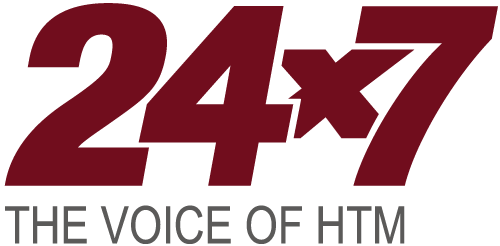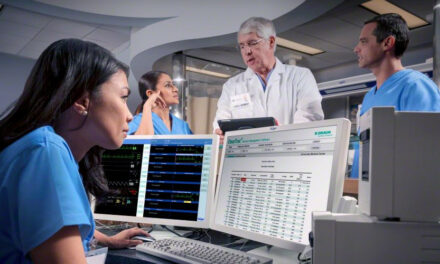HTM leaders share how data, collaboration, and strategy guide smarter medical equipment replacement decisions.
By Alyx Arnett
Healthcare technology management (HTM) teams face a deceptively simple question every day: repair, replace, or invest in something new? The right answer doesn’t come from gut instinct or the latest request, stakeholders say. Instead, it comes from having a long-range plan grounded in data. Across the field, HTM leaders are formalizing multiyear strategies that connect technical realities, clinical impact, and financial sustainability.
At Yale New Haven Health, that connection is now a systemwide mandate. “Knowledge and data are essential tools in today’s environment,” says Samantha Herold, MS, CCE, director of clinical engineering for the seven-hospital system. “Having a good inventory and being confident in its accuracy is the key because then you can start grouping by asset types and seeing where the greatest need is.”
Four years ago, Herold’s team helped process about $500,000 in capital equipment through a nascent planning process. Last year, they shepherded $50 million—an expansion she credits to strong governance, standardization, and a five-year plan that is refreshed annually.
Veteran HTM leader Paul Kelley, CBET, AAMIF, saw a shift from individual departments at his former hospital making their own replacement calls to clinical engineering taking on a larger role. “They were extremely happy to just let somebody else do it for them,” Kelley says. That shift helped move replacement planning from a reactive process into a proactive strategy tied to long-term capital goals.
The Case for HTM-Led Planning
When equipment planning is handled separately across departments, organizations often end up replacing the “squeakiest wheel.” But as Kelley says, the loudest complaints don’t always reflect the highest risks or the greatest needs.
He saw those limitations firsthand. “In the early days, there was nothing formal about the replacement plan,” he says. To bring more structure, he began sending reports that highlighted device age and technologies that were no longer supported. That effort grew into annual meetings with nursing leaders to align on priorities.
In large, integrated systems, centralized oversight helps prevent duplication, promotes standardization, and ties purchasing decisions to long-term support costs. At Yale New Haven Health, clinical engineering has a seat on the capital committee that oversees everything from small movable equipment to high-end imaging.
The team partners with service lines—including diagnostic imaging, heart and vascular, and radiation oncology—and enterprise categories such as EKG carts, anesthesia machines, patient monitoring, and nurse call to build a plan for replacements. “We focus on the heavy hitters that will have the most impact for our care teams and patients,” Herold says.
Standardization, Herold says, is one of the biggest advantages of having HTM at the table. “If you’re able to demonstrate the savings and operational efficiencies around standardizing to one device across your organization, the benefits are just tremendous,” she says. Beyond cost savings, standardization simplifies IT integration, training, supply chain management, and technical support.
Achieving it requires strong administrative buy-in and a willingness to guide departments toward a shared decision. “You may not get a unanimous decision, but you go with the majority,” Herold says. “Then the technical teams and the supply chain team work our hardest to make sure that the technology is implemented, safe, and effective for them to use.”
Building the Data Foundation for a Long-Range Plan
For many HTM teams, a true three- to five-year plan feels out of reach. Kelley says his group “never got to the holy grail” of multi-year forecasting. Staffing and budget limits made it hard to look beyond annual cycles or bring in outside help.
Samantha Jacques, PhD, FACHE, vice president of clinical engineering at McLaren Healthcare, says getting there starts with data. “You have to have the right data to start, maintain, and continue this effort,” she says. This includes tracking the cost of support and repairs, documenting end-of-life and end-of-support dates, and monitoring operating systems and patch levels to identify cybersecurity or reliability concerns. “Think about what you need to add to your CMMS to make these efforts easy to implement,” she says.
As a first step, Herold says, start with inventory. Before Yale New Haven Health built its five-year plan, clinical engineering completed inventory validation projects to ensure data accuracy across its system. “If someone came to us and said their sterilizer was broken and needed replacement, we would look at the fleet and validate the inventory we had,” Herold says. “It’s a labor of love and an arduous process, but knowledge and data really are the ultimate tools in your tool belt when it comes to clinical engineering capital planning.”
With accurate inventory data, Herold says, teams can begin identifying trends: where the greatest needs are, what the average age of a fleet looks like, which devices have end-of-support notices, or where antiquated technology still lingers. The same information can reveal opportunities for standardization. “Do we have six different EKG carts across the health system? Do we want to try to standardize to one?” she says. “That knowledge base of that inventory is ultimately the first critical step to being able to do this.”
Kelley advises mining the data at least annually to catch shifting patterns. Repair frequency spikes, rising contract costs, or user dissatisfaction can all warrant a reassessment.
Carol Davis-Smith, MS, CCE, FACCE, AAMIF, president of Carol Davis-Smith & Associates, suggests an “executive stoplight” that sorts needs across a five-year horizon. Years one and two are red—assets requiring an immediate game plan to replace, upgrade, or otherwise mitigate. Years three and four are yellow—assets that are not urgent but require planning. Beyond that are green assets that are still viable.
The payoff, Herold says, is daily clarity. “We used to be fielding requests first in, first out,” she says. “Having the replacement plan gives the organization a holistic view of the fleet.” It also changes how “no” is delivered. “We can say, ‘This is not the year to replace that device, but we are aware of it. It is on our five-year plan, and it’s going to be replaced in year three,’” she says.
As teams work to sustain a long-term plan, Davis-Smith encourages leaders to delegate strategically. “Quit trying to do everything yourself,” she says. “Take a breath, step back. Look at this strategically.” Not every task has to sit with the same technicians handling repairs and maintenance, she says. She suggests reassigning responsibilities, tapping interns or analysts for data work, and bringing in help when needed. The goal is to get “the right people doing the right work”—without overloading star performers.
Working End-of-Life Data into Equipment Planning
End-of-life data is one of the most important inputs for long-term planning. Davis-Smith says determining it requires weighing three key factors—technical, clinical, and financial—to understand when equipment has truly reached the end of its life.
The technical aspect encompasses factors such as manufacturer end-of-support dates, parts scarcity, reliability trends, and the device’s cybersecurity profile. At Yale New Haven Health, Herold’s team translates cyber considerations into a consistent scoring model. “If something is Windows XP, for example, that’s going to get a 10 out of 10 risk score,” she says.
While those technical factors are often quantifiable, Davis-Smith says the clinical side can be much harder to define. “If it’s clinically obsolete, that might mean it’s still manufactured and serviced, but it does not do the clinical thing the provider needs.”
She points to an example of lung cancer screening protocols introduced several years ago. When new reimbursement models and care guidelines took effect, many CT scanners couldn’t perform the required low-dose scans. “Your current CT system wasn’t obsolete for all the normal things, but it could not do what you needed for this lung screening protocol,” she says. “It became a clinical end-of-life conversation.”
Financial data—such as depreciation and total cost of ownership—may be more straightforward but still require nuance. A device nearing financial end-of-life at a flagship hospital, for instance, might still hold value if relocated to an outpatient center where access is limited or reimbursement is more favorable.
“Usually it’s a single factor that lands a piece of equipment on the replacement list, but if the device has multiple factors, then the priority for replacement moves it up on the list,” Jacques says.
Evaluating New Technology Without Falling for the ‘Shiny Object’
New technology can bring meaningful improvements—but it can also become a costly disappointment if adopted too quickly. Kelley recalls one such case. “Some physicians were pushing hard to get this new technology,” he says. “We got it, and a very short time later, they were all in storage because nobody was using them. They rushed it through instead of being able to evaluate it thoroughly.” His takeaway: “Trial it if you can, and investigate it as deeply as possible.”
Kelley advises teams to research how long a device has been on the market and where it sits in its product lifecycle. “Most of the time you don’t want to put all your eggs in one brand-new basket,” he says. “But you also don’t want something that’s been on the market for a decade because it’s probably going to be updated soon.” Resources such as ECRI and MD Buyline, he adds, can help determine a technology’s maturity and performance compared with alternatives.
For Davis-Smith, thoughtful evaluation is where HTM teams can make the biggest impact. “This is the shiny-object dilemma. It’s been around forever, and it’ll always be around,” she says. “Some of these medical device companies have the most amazing marketing people ever. My job is to sort through all of that and see fundamentally what is the difference. Is it really going to make a clinical difference?”
That process, she adds, is part of the “management” in healthcare technology management. “HTM isn’t healthcare technology maintenance; it’s healthcare technology management,” she says. “That includes looking at what’s coming down the pike, understanding the engineering behind it, and participating in that conversation with clinicians.”
Partnering with clinicians early can prevent missteps. “We need to understand what they’re doing clinically,” Davis-Smith says. “We’re not doctors. We’re not nurses. But that doesn’t prevent us from understanding what they’re trying to do and being able to have a relationship built with them. Be their partner in evaluating these technologies.” Those conversations, she says, can confirm a strong clinical case—or reveal that a new device “is a better widget, but it’s not going to change what you do.”
At Yale New Haven Health, Herold says new technology requests follow a structured, two-stage review. Truly novel products first undergo a clinical governance review involving clinical engineering and cybersecurity. From there, growth-related requests move into business planning, where teams must justify projected revenue and operational impact. The goal is to avoid one-off purchases that complicate training, support, and supply chain and to ensure innovation aligns with system standards.
Aligning Contracts with Long-Term Strategy
Warranties, service contracts, and vendor agreements should be central to any long-term equipment plan. “These all play a role in our 10-year total cost of ownership calculations,” Jacques says. “Organizations should be looking at how much they are spending over the entire life of the device, not just the purchase.”
At Yale New Haven Health, Herold’s team uses that perspective to strengthen negotiations. “If you’re going to be the chosen vendor for our MRI technology, we’re getting 18 to 24 months of warranty,” she says. “We’re not taking a standard 12-month, and that’s because we have a plan.” By standardizing equipment and projecting replacements, her team can secure multi-year price locks and leverage future volume. “We’ll say you’ll get 90% of our anesthesia machine business if you lock in this pricing over the next three years,” she adds.
Kelley urges HTM leaders to read the fine print before signing. “Know what’s in your contract,” he says. “A lot of companies will verbally tell you things and then put something different.” He advises checking guaranteed response times, uptime commitments, and who performs the work. Avoid paying for vendor installation on simple assemblies, he adds, and tailor warranties to the team’s capabilities. Shorter terms, he says, can make sense for device lines that an in-house team already supports.
For teams working on multi-year forecasts, Davis-Smith says contract planning should mirror the replacement plan. Assets scheduled for phase-out shouldn’t carry multi-year service agreements, while equipment in the “green zone” may benefit from extended contracts that lock in rates and reduce administrative load. “It’s about aligning your service strategy with your capital strategy,” she says.
The Bottom Line
Effective equipment planning isn’t about predicting every need years in advance. It’s about using reliable data and clear communication to make better decisions when the time comes, Herold says.
Yale New Haven Health’s five-year plan has helped create “a single source of truth” that makes decisions more transparent and aligned with patient care priorities, Herold says.
Kelley says progress starts with the basics: keeping inventories accurate, tracking supportability, and listening to users. Jacques points to the value of linking lifecycle data to broader strategy—whether coordinating group buys, shifting equipment across sites, or negotiating better total-cost-of-ownership terms. Davis-Smith says that kind of visibility also elevates HTM’s role. When clinical engineering can speak to clinical and operational needs, not just technical ones, it earns a stronger voice in planning discussions.
Across each approach, the goal is the same: move from reactive replacements to a managed process grounded in data and collaboration. As Davis-Smith puts it, “Open your mind. Just because we’ve done it this way does not mean we have to continue doing it that way.”





Great Article that touches on efficient device management taking into account engaging with stakeholders and TCO.
If you want to manage equipment correctly in a hospital environment, this article is a must read. Any hospital would benefit greatly from these ideas.